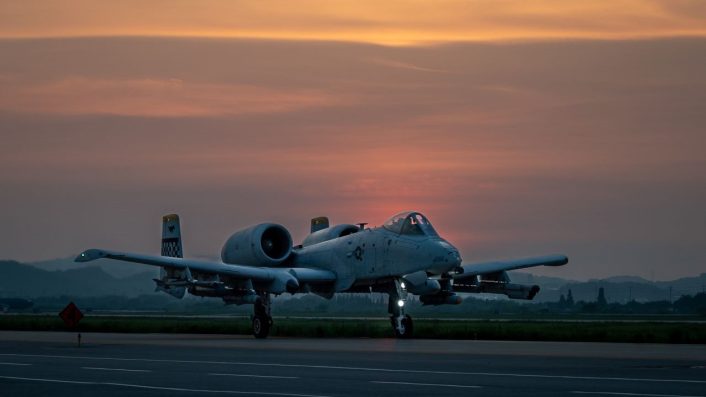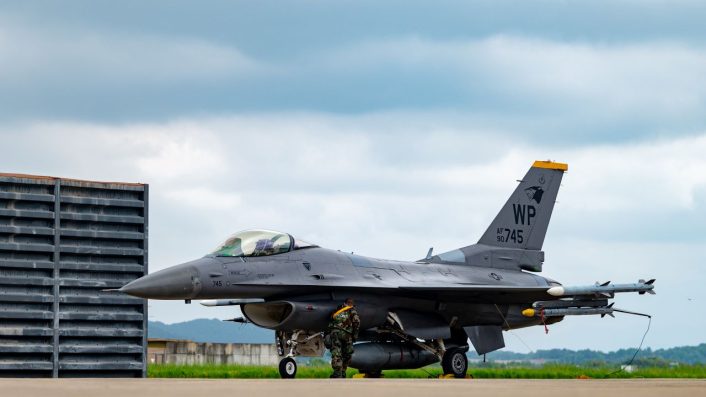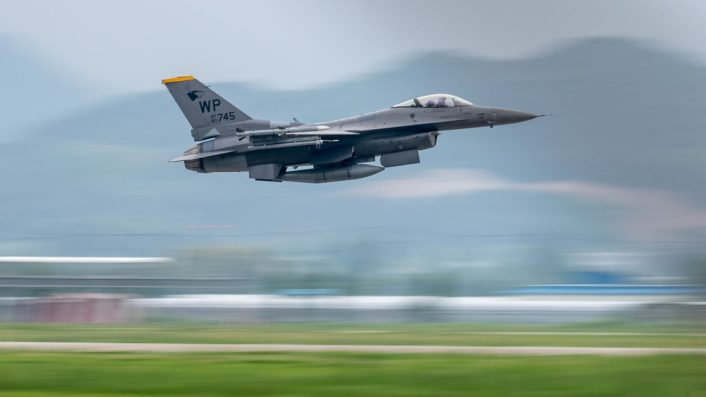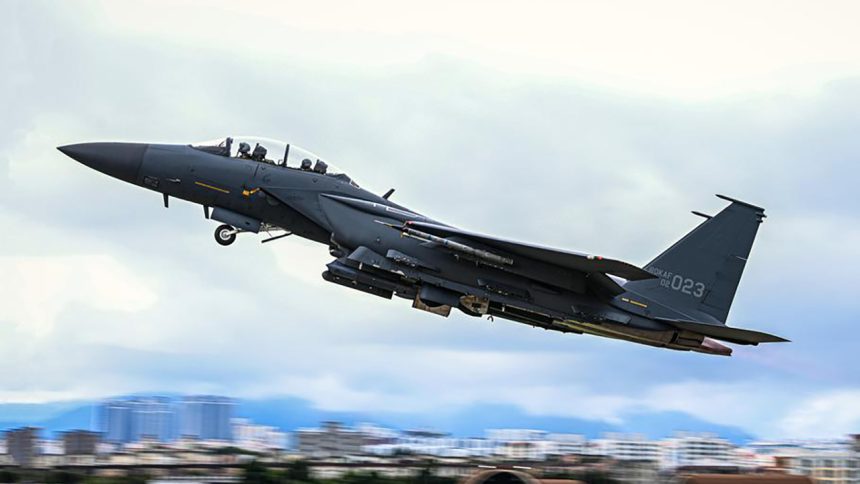Ulchi Freedom Shield 24 will see the participation of 200 aircraft, including South Korean F-15Ks, FA-50s, and KF-16s and US F-16s and A-10s, which are expected to fly more than 2,000 sorties around the clock.
This year’s edition of the joint South Korea and the U.S annual Ulchi Freedom Shield exercise, which kicked off on Aug. 19, 2024 has a lot of firsts. Among the most notable is the rehearsal, for the first time, of the response to a North Korean nuclear strike against South Korea.
An interesting feature is the practice of ACE (Agile Combat Employment) operations by the 8th and 51st Fighter Wings of the U.S. Air Force as well as the ROKAF (Republic of Korea Air Force) units. South Korean reports also said the air combat component will see what has been defined as the largest ever number of sorties planned, reportedly 2,000, around the clock.
More than 200 South Korean and US aircraft will participate. The US’ 8th Fighter Wing based at Kunsan Air Base and 51st FW at Osan Air Base announced their integration into the exercise, saying they incorporated the recurring wing readiness exercises into Ulchi Freedom Shield 24. The ROKAF will reportedly participate with the 11th, 16th and 20th Fighter Wings, which are equipped with F-15K, FA-50 and KF-16 jets.
Other goals include countering North Korea’s missile and cyber threats in 40 different kinds of field exercises, which will last until Aug. 29. The drills will also include unspecified computerized simulations components.
The Chosun Daily mentioned that “this year’s drill, for the first time, includes government response training for a hypothetical North Korean nuclear attack.” The report further added that “the primary focus of this year’s exercise is to master specific response measures in the event of a North Korean nuclear strike.”

The ROK and the U.S. Air Forces will undertake “120 hours of continuous day and night sorties for 5 days” for multi-domain missions, according to an automated translation of a video released by Yu Yungwon TV. The aircraft will practice both Defensive Counter Air missions, as well as air interdiction, with virtually simulated targets including cruise missiles and high-speed aircraft.
About 19,000 South Korean military personnel will participate in the drills, which will be held alongside civil defense and evacuation drills. The exercise will “reflect realistic threats across all domains,” South Korea’s Joint Chiefs of Staff was quoted by DW.
The U.S. stations around 28,500 troops in the ROK. The UFS 24 exercise also comes after US and Allies, including the ROK, Japan and Australia, wrapped up the annual Pacific Dragon 24 exercises, which also saw the firing of the ship-launched Standard Missile-series.
8th Fighter Wing
Saying that it has begun integrating into the UFS 24, the 8th FW, also known as the “Wolf Pack” and equipped with the F-16CM Block 40, mentioned it will conduct local flying and ACE (Agile Combat Employment) operations at forward locations to increase interoperability with mission partners in realistic combat scenarios. “These scenarios directly support the exercise’s focus on conducting multi-domain operations leveraging component assets, emphasizing countering weapons of mass destruction,” added the press release.
“It is imperative to link the Wolf Pack with the operational level of command,” said the 8th FW commander, Col. Peter Kasarkis. “These connections do not happen automatically and must be rehearsed. Exercises such as Ulchi Freedom Shield provide the sandbox to allow us to continuously improve.”
Additionally, the Wolf Pack is “testing its wing’s readiness, including its ability to support follow-on forces and defend the base against regional threats.” The commander further added that “participation in these exercises builds a more combat-ready force, better able to meet any challenge in the Indo-Pacific region.”
The 8th FW had also publicized its ACE practices during the Beverly Pack 24-1 held between May 7-9, 2024, which saw “67 airmen deployed to Gwangju Air Base” to “operate in unfamiliar locations at a moment’s notice.” The press release added that “the exercise challenged the wing’s retrieval, refueling, and aircraft launch capabilities while advancing Airmen’s knowledge and skills to effectively generate airpower across the Indo-Pacific region.”
ACE essentially means operating out of austere locations, airfields with minimal supporting and technical infrastructure in order to spread out from the larger bases that are likely to come under a sudden adversary missile barrage. An extension of ACE is Dynamic Force Employment where bombers or fighters quick movement of forces, and the ability to operate soon after reaching the deployed location and perform their mission.

51st Fighter Wing
The 51st FW at Osan Air Base, meanwhile, is incorporating its recurring wing readiness exercise into UFS 24 for the first time in recent history. Similarly to the 8th FW, the 51st FW will also conduct local flying and ACE operations to not only enhance local wing readiness, but also reinforce U.S. Seventh Air Force and U.S. Forces Korea’s command-and-control training efforts.
The Wing, Seventh Air Force and the U.S. Forces Korea will “engage in contingency response exercises, training on mobilization and force deployment capabilities while simultaneously rehearsing the protection and sustainment of base operations,” said the press release. But the highlight would be aircraft and personnel mobilizing and operating “out of a co-operating base location in the Republic of Korea, further enhancing the wing’s ability to execute the mission in an unfamiliar environment at a moment’s notice.”

Korean Reports
Yu Yongwon TV meanwhile released footage of ROKAF F-15Ks, FA-50s and KF-16s being serviced by ground crew and taking off during day and night-time sorties. The video said the ROKAF and the U.S.A.F will fly “120 hours of continuous day and night sorties for 5 days, strengthening wartime operational capabilities,” with a total of “2,000 sorties, the largest ever.” Interestingly, there were no mention of the ROKAF F-35’s participation.
The 200 aircraft participating include F-15Ks, FA-50s, and KF-16s of the 11th, 16th, and 20th Fighter Wings of the ROK Air Force, the F-16s and A-10s of the 51st Fighter Wing and the F-16s of the 8th FW of the U.S. Air Force. “This is the first time that multiple ROK and US Air Force squadrons have simultaneously conducted 24-hour live flight training for multi-domain missions,” said the reports.
Missions like Defensive Counter Air (DCA), Air Interdiction (AI) and Airborne Alert Interdiction (X-INT) are mentioned among the missions that will be conducted to ensure the absence of gaps in the air defense posture during the day and night. “This training is characterized by maximizing response capabilities. If an aircraft conducting defensive counter air training receives an order similar to a real situation, it will immediately switch to combat surveillance and perform it,” said the report.
This suggests the retasking during the flights, where fighters switch from one type of mission to another. “Virtual enemy formation will be deployed to simulate high-speed aircraft infiltration and cruise missile launches,” said the report, further adding that the training for “air units to support air operations” would involve “mass ammunition assembly, maximum armament loadout, and emergency return and re-departure.”









